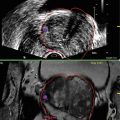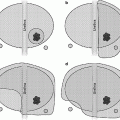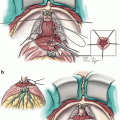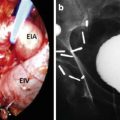MSKCC report for 1,176 patients between 2003 and 2005 [2]
RRP
LRP
p value
N = 692
N = 484
Mean operating room time (min) (n = 946)
188 (SD 41)
199 (SD 47)
<0.0005
Mean estimated blood loss (cm3) (n = 1,070)
1,267 (SD 660)
315 (SD 186)
<0.0005
No. transfused (%)
338 (49 %)
14 (3 %)
<0.0005
Mean length of stay (days) (n = 465)
3.3 (SD 1.2)
2.0 (SD 1.5)
<0.0005
ER return visit
75 (11 %)
75 (15.5 %)
0.02
Reoperation
3 (0.4 %)
9 (1.9 %)
0.03
No. readmitted (%) (n = 1,162)
8 (1.2 %)
22 (4.6 %)
0.001
Other investigators compared ORP and LRP and have reported similar results with comparable rate of positive surgical margins, comparable rates of biochemical recurrence (BCR), lower EBL, and need for transfusion in LRP-treated patients [3–5]. In a recent review of outcomes after ORP, LRP, and robot-assisted laparoscopic prostatectomy (LARP), Coelho et al. reviewed the contemporary literature from high volume centers and found mean EBLs of 951 mL and 291.5 mL in ORP and LRP, respectively. This review also showed a lower rate of transfusion needed in LRP (20.1 % and 3.5 % for ORP and LRP, respectively) [6]. While it has been recently suggested that EBL does not affect the oncologic outcome [7], this conclusion was made after analyzing the outcome of 1,567 men who underwent ORP, and thus these results do not necessarily reflect a possible advantage of lower EBL in LRP.
While magnification, better accessibility, and the antegrade surgical approach help, the collapse of venous plexuses by the positive intra-abdominal pressure is the main contributor to the lower blood loss during LRP. A temporary increase of the pneumoperitoneum pressure to 20 mmHg during transection of the dorsal vascular complex allows for tamponade and accurate venous closure.
A retrospective review of 4,592 consecutive patients treated at MSKCC with either ORP (3,458 patients) or LRP (1,134 patients) between 1999 and 2007 found a higher overall rate of both medical and surgical postoperative complications in the LRP group (8.8 % and 14.5 % rates of medical complications in ORP and LRP, respectively, and 18.7 % and 24.5 % rates of surgical complications in ORP and LRP, respectively), but a lower rate of major surgical complications (grades III–V), most of which were bladder neck contractures [8]. The lower rate of bladder neck contractures in LRP was also shown by others, as was the need for additional surgical interventions for the correction of these contractures [9].
Oncologic Outcomes
Positive Surgical Margins
A positive surgical margin (PSM) is defined as cancer cells at the inked margin of resection. A positive surgical margin at radical prostatectomy is associated to a higher risk of recurrence and has been associated with an increased risk for both local and systemic recurrence after treatment [10–12]. The goal of any surgical technique used for treatment of cancer is complete excision with negative surgical margins, extended pelvic lymph node dissection whose role is still debated thus lowering or delaying the risk of recurrence.
The rate of positive surgical margins reported in large LRP series ranges between 11 % and 26 % [2, 8, 13–15]. The rate of PSMs varies with pathologic stage and grade and ranges from 9.1 % PSM rate in patients with low risk disease to 36.8 % in a high risk group. This is comparable to previously reported rates of PSMs of 20–27 % in ORP series [16, 17] and those reported in series comparing ORP and LRP (Table 5.2).
Table 5.2
Surgical margin analysis
Report | Publish | Number of patients | Surgeons | RRP (%) | LRP |
|---|---|---|---|---|---|
Lepor et al. [16] | 2001 | 1,000 | Single | 19.9 | |
Vickers et al. [17] | 2010 | 7,765 | 72 (multi-institutional) | 27 | |
Guillonneau et al. IMM [13] | 2003 | 1,000 | 3 | 6.9 % pT2a | |
18.6 % pT2b | |||||
30 % pT3a | |||||
34 % pT3b | |||||
Guillonneau et al. MSKCC [28] | 2008 | 1,564 | 2 | 13 % | |
Touijer et al. [2] | 2008 | 1,430 | 4 (2 RRP and 2 LRP) | 11 | 11 % |
Rabbani et al. [8] | 2009 | 4,592 | – | 14.6 | 11.3 % |
Eden et al. [14] | 2009 | 1,000 | Single | 13.3 % | |
Paul et al. [15] | 2010 | 1,115 | 3 | 5.5 % pT2a | |
10 % pT2b | |||||
33 % pT3a | |||||
40 % pT3b | |||||
Busch et al. [31] | 2012 | 1,845 | 8 | 29.20 % |
PSMs have been shown to be associated with a higher risk of recurrence and shorter recurrence-free survival. Busch et al. recently reported that with a median follow-up of 56 months the 10-year BCR-free survival was 59.2 % vs. 82.9 % in patients with and without PSM, respectively [18]. They also found that clinical stage T2, biopsy Gleason sum >7, and higher preoperative PSA levels were all independent predictors of PSM.
Identifying the risk factors for PSMs (Table 5.3) improves the ability to decrease the percentage of patients with PSMs, and thus improves the outcome of patients. Secin et al. analyzed the preoperative and intraoperative risk factors for PSM in 407 patients treated with LRP [19]. Some of the factors associated with PSMs are well known, such as high preoperative PSA and Gleason score of 7 or more. Also shown, as known from ORP, was that lower prostate volume is a risk factor for PSMs, and that there is a trend for more PSMs on the left side for right-sided surgeons standing to the left of the patient during surgery.
An interesting association was found between the technique of NVB dissection and rate of PSMs. Results of multivariable analysis showed that dissection in the interfascial plane was associated with a fourfold increase in risk for PSMs when compared to intrafascial plane dissection. While this may be counterintuitive, as interfascial dissection is further from the prostate, this probably reflects our inaccurate preoperative assessment of extent of disease.
While the significance of apical PSMs, the most common site of PSMs both in ORP and LRP, and their effect on the chance of BCR are controversial [20–22], the aim in performing a prostatectomy for prostate cancer is to avoid them. Leaving the urethra to be cut last improves the anatomical orientation of the surgeon and lowers the rate of apical PSMs.
Posterolateral PSMs hold a higher risk for BCR than apical PSMs. To lower the rate of posterolateral PSMs special attention should be paid when dissection of the NVB is conducted with intent to preserve the nerves.
Pelvic Lymph Node Dissection
The presence of lymph node metastases in prostate cancer is associated with poor outcome. The most accurate way to stage the pelvic lymph nodes is by performing a pelvic lymph node dissection (PLND) at the time of prostatectomy. This allows for better identification of patients with lymph node metastases, allows for better prognostication, and improves the decision making regarding the need for further treatment. While PLND has a prognostic importance by better staging the patients, it has also been shown to have a therapeutic effect. The extent of lymph node dissection has also been shown to be important, as the more extensive a dissection is performed the higher the chances are of finding positive lymph nodes. The lymph node count has also been shown to be an objective indicator of the quality of surgery [23].
The use of prostate-specific antigen (PSA) for screening men for prostate cancer has caused a downward stage shift with an increasing number of patients diagnosed with low risk prostate cancer during the PSA screening era [24]. This has led some surgeons to omit a pelvic lymph node dissection during radical prostatectomy in men with lower risk prostate cancer. This trend found fertile ground among minimally invasive surgeons as a way to shorten surgical time.
A comparison of ORP and LRP performed at MSKCC showed a comparable number of lymph nodes extracted (12 and 13 for ORP and LRP, respectively) [2].
Other groups have reported on different criteria for performing a PLND with varying percentage of patients receiving a PLND and different percentage of patients found to have nodal metastases. The Montsouris group selected patients with cT2b, PSA > 10, and predominant Gleason pattern 4 for PLND. Of 1,000 patients, 216 (21.6 %) underwent a PLND, using these definitions, and 6 (0.6 % of the entire cohort) were found to have nodal metastases [13]. Stolzenburg et al. reported their recent experience of endoscopic extraperitoneal radical prostatectomy in which a PLND was performed on patients with PSA >10 ng/mL and/or a Gleason sum >6. This selection resulted in 1219 PLNDs (50.8 %) with metastases detected in 75 patients (6.1 %). Recently, the Henri Mondor Hospital reported oncologic outcomes based on 1,115 extraperitoneal LRPs. Limited PLNDs were performed in 75 % of the patients (those with biopsy Gleason score >6 and/or PSA >10 ng/mL), yielding a median 3.5 nodes per side and detecting lymph node metastases in 24 patients [15].
The reverse shift of stages seen among patients treated with radical prostatectomy, as more patients with low risk prostate cancer are put on active surveillance protocols [25], supports the importance of performing an extended lymph node dissection instead of omitting it. For these reasons, the MSKCC indications and anatomical template for PLND during LRP have changed from performing no lymphadenectomy for men with low risk of nodal metastases (<2 %) and a limited lymphadenectomy for those with patients with ≥2 % risk (as determined by a nomogram), to performing an extended PLND dissection in all patients undergoing LRP. This modification has allowed retrieval of higher median nodal counts (13 [IQR 9–18] and 9 [IQR 6–13], respectively, p < 0.001) and increased threefold the detection of positive lymph nodes (14.3 % and 4.5 %, respectively) [27]. We concluded that a PLND including the external iliac, obturator, and hypogastric lymph node groups yields positive nodes more frequently and retrieves a higher total nodal count than the often-performed lymph node dissection limited to the external iliac nodes [28, 29] (Table 5.4).
Table 5.4
Laparoscopic pelvic lymph node dissection
Report | Number of patients | Underwent PLND | Criteria | Metastases (%) | Median lymph nodes retrieved |
|---|---|---|---|---|---|
Guillonneau et al. IMM [13] | 1,000 | 21.6 %(216) | PSA > 10, cT2b and G 4 | 0.6 | – |
Stolzenburg et al. [26] | 2,400 | 50.8 % (1219) | PSA > 10 or G >6 | 6.1 | – |
Paul et al. [15] | 1,115 | 41.6 % (464) | PSA > 10 or G >6 | 2.2 | 7 |
Touijer et al. [27] | 971 | 46 % (447) | Nomogram ≥2 % | 14.3 | 13 |
Guillonneau et al. MSKCC [28] | 1,564 | 58 % (828) | Nomogram >1 % | 7 | 12 |
Biochemical Recurrence
Most available data show favorable short-term and mid-term oncologic outcomes after LRP.
In a report on 1,564 consecutive patients treated with LRP in L’Institut Mutualiste Montsouris and at MSKCC, by one of two surgeons, the actuarial probabilities of remaining free of BCR at 5 and 8 years postoperatively were found to be 78 % and 71 %, respectively. The median follow-up for patients without BCR in this study was 1.5 years. The 5-year progression-free probability for men with low, moderate, and high risk prostate cancer was 91 %, 77 %, and 53 %, respectively. The 5-year progression-free probability after LRP was 83 % among patients with pathologic organ-confined disease and negative lymph nodes and 69 % among patients with pathologic non-organ-confined disease and negative lymph nodes.
In a summary of the first 1,115 LRP cases at the Hospital Henri Mondor, Paul et al. found a 3-year and 5-year recurrence-free survival rates of 84 % and 83 %, respectively [15]. Most of the patients (60 %) in this cohort had pathologic organ-confined disease, 23 % had extracapsular extension, 10 % had seminal vesical invasion, and 7 % had pathologic T4 disease. Positive lymph nodes were found in 24 (2.2 %) of patients, and 26 % of patients had PSMs. The 5-year progression-free survival rates were 93.4 %, 70.2 %, and 42.7 % for patients with pT2, pT3, and pT4 diseases.
Hruza et al. recently reported on long-term oncologic outcomes in 500 consecutive patients treated with LRP, of which 370 had complete data and were included in the analysis. Of these, 60 % had pathologic stage T2, 21 % had stage T3a, and 19 % had stage T3b/T4. Gleason 6 or less was found in 49 % of patients, while 41 % had Gleason 7, and 10 % had a Gleason sum of 8 or more. With a median follow-up of 105 months, the 10-year BCR-free survival rate was reported to be 70.6 %. When stratified according to pathologic stage, patients with pT2 had a 10-year BCF-free survival rate of 82.3 % while patients with pT3a and pT3b/pT4 diseases had a 10-year BCR-free survival rate of 54.1 % and 52.8 %, respectively [30].
Busch et al. also reported on long-term oncologic outcomes of 1,845 evaluable patients treated with LRP. With a median follow-up of 56 months, a 10-year overall survival rate of 92.5 % and a 10-year BCR-free rate of 75.6 % were found. This cohort included 50 % of patients with low risk disease, 39 % with intermediate risk, and 11 % with high risk disease according to D’Amico’s risk groups [31] (Table 5.5).
Table 5.5
Biochemical recurrence
Report | Number of patients | Progression-free stratified risk | Global BCR-free (%) | Time after surgery (years) | ||
|---|---|---|---|---|---|---|
Guillonneau et al. [28] | 1,564 | Low | 91 % | 78 | 5 | |
Int. | 77 % | |||||
High | 53 % | |||||
Paul et al. [15] | 1,115 | pT2 | 93.4 % | 83 | 5 | |
pT3 | 70.2 % | |||||
pT4 | 42.7 % | |||||
Hruza et al. [30] | 370 | pT2 | 82.3 % | 70.6 | 10 | |
pT3 | 54.1 % | |||||
pT4 | 52.8 % | |||||
Busch et al. [31] | 1,845 | Low | 1.00 | HR | 75.6 | 10 |
Int. | 2.03 | |||||
High | 3.81 | |||||
Functional Outcomes
In addition to cancer control, patients with prostate cancer are concerned about functional outcomes after treatment. The main concerns are regarding continence and erectile function and their impact on quality of life, acknowledging that infertility is constant and that sperm banking should be offered to all patients prior to any surgery.
Continence
Urinary incontinence is a bothersome problem after prostatectomy. It has many implications, both social and personal, and is a major contributor to lower quality of life after surgery. Several preoperative measures have been identified to predict postoperative continence, including age, prostate volume, urethral length, BMI, and comorbidities. A previous transurethral resection of the prostate (TURP) has also been implicated as a risk factor for post-prostatectomy incontinence (Table 5.6).
Table 5.6
Incontinence risk factors
Incontinence risk factors |
|---|
Age |
Prostate volume |
Urethral length |
BMI |
Comorbidities |
TURP |
While it is hard to summarize the continence rates after LRP because of different continence definitions used in the different reports and the reporting of continence at different time points after LRP (Table 5.1), overall the continence rates after LRP are good and comparable to previously reported continence rate after ORP.
Ploussard et al. looked at continence rates in 911 patients treated with LRP, who prospectively completed self-administered questionnaires, using a strict definition of no urine leak or pad use. They found that 94.4 % and 97.4 % were continent 1 and 2 years after surgery, respectively, using these strict definitions [32].
Busch el al. reported on a 74.9 % rate of continence after LRP in a cohort of 1,845 patients with a median follow-up of 56 months. They used a definition of the need for 0–1 pads per day [31].
Eden et al. reviewed their first 1,000 cases of LRP for cT1-3 prostate cancer and found that while only 10 % of patients were continent at the time of catheter removal after surgery, the pad-free rate increased to 94.9 % at a median follow-up of 27.7 months [14] (Table 5.7).
Table 5.7




Continence rates after laparoscopic radical prostatectomy
Stay updated, free articles. Join our Telegram channel

Full access? Get Clinical Tree








